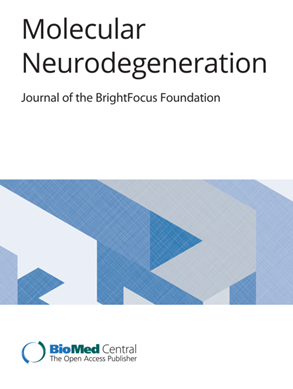Srebf2 mediates successful optic nerve axon regeneration via the mevalonate synthesis pathway
IF 17.5
1区 医学
Q1 NEUROSCIENCES
引用次数: 0
Abstract
Axon regeneration within the mammalian central nervous system is extremely limited. In optic neuropathy conditions like glaucoma, the inability of retinal ganglion cell (RGC) axons to regenerate is a major impediment to functional recovery. In contrast, adult teleost fish such as zebrafish can fully regenerate RGC axons enabling visual recovery from optic nerve (ON) injury making it an ideal model to probe the mechanisms of successful axon regeneration. Laser Capture Microdissection followed by RNA-sequencing (LCM-seq) was used to identify genes and pathways differentially expressed in RGCs during ON regeneration. We validate these findings by in situ hybridization and qRT-PCR. Using loss- and gain-of-function experiments we demonstrate the necessity of srebf2 for efficient ON regeneration and recovery of visual function. Finally, we use LCM-seq coupled with experimental manipulations to identify downstream srebf2 target genes and test the role of hmgcra/b and mevalonate in this process. Statistical analysis was performed using Student’s t-test, two-way ANOVA, or repeated measures with appropriate post-hoc tests where applicable. LCM-seq comparison of uninjured versus 3-day post ON injury RGCs identified significant upregulation of the cholesterol synthesis pathway during axon regeneration. The master regulator of this pathway, the transcription factor srebf2, is upregulated throughout the regeneration phase. Chemical inhibition or morpholino-based gene knockdown of srebf2 decreased axon regeneration into the ON and optic tectum and delayed recovery of visual behavior over the course of normal optic nerve regeneration without causing a significant loss of RGCs. Constitutively active srebf2 can fully rescue axon regeneration and visual behavior losses caused by inhibition of endogenous srebf2 but does not accelerate regeneration compared to the control group. LCM-seq confirms the expected regulation of predicted srebf2 target genes after loss- or gain-of-function in vivo. Downstream of srebf2, hmgcra/b knockdown or simvastatin treatment delayed axon regeneration and this effect was rescued by supplemental mevalonate. Mevalonate treatment alone was sufficient to accelerate ON regeneration. These results demonstrate that srebf2 and the downstream mevalonate synthesis pathway plays an important role in regulating efficient axon regeneration in the zebrafish visual system. Involvement of this pathway should be closely examined in failed mammalian ON regeneration.Srebf2通过甲羟戊酸合成通路介导视神经轴突再生
哺乳动物中枢神经系统的轴突再生极为有限。在像青光眼这样的视神经病变中,视网膜神经节细胞(RGC)轴突无法再生是功能恢复的主要障碍。相比之下,斑马鱼等成年硬骨鱼可以完全再生RGC轴突,使视神经损伤后的视觉恢复,使其成为探索轴突成功再生机制的理想模型。采用激光捕获显微解剖和rna测序(LCM-seq)技术鉴定ON再生过程中rgc中差异表达的基因和途径。我们通过原位杂交和qRT-PCR验证了这些发现。通过功能丧失和功能获得实验,我们证明了srebf2对于视觉功能的有效再生和恢复的必要性。最后,我们利用LCM-seq结合实验操作鉴定了srebf2下游靶基因,并测试了hmgcra/b和甲羟戊酸在这一过程中的作用。统计分析采用学生t检验、双向方差分析或重复测量,并在适用的情况下进行适当的事后检验。LCM-seq比较未损伤与损伤后3天的RGCs发现,轴突再生过程中胆固醇合成途径显著上调。这一途径的主要调控因子,转录因子srebf2,在整个再生阶段被上调。化学抑制或基于morpholino的基因敲低srebf2会减少轴突向ON和视神经顶盖的再生,并在正常视神经再生过程中延迟视觉行为的恢复,而不会导致RGCs的显著损失。与对照组相比,组成活性srebf2可以完全挽救内源性srebf2抑制引起的轴突再生和视觉行为丧失,但不加速再生。LCM-seq证实了预期的srebf2靶基因在体内功能丧失或获得后的预期调节。srebf2下游,hmgcra/b敲低或辛伐他汀治疗延迟轴突再生,这种效果通过补充甲羟戊酸恢复。甲羟戊酸单独治疗足以加速ON再生。这些结果表明,srebf2和下游甲羟戊酸合成通路在调节斑马鱼视觉系统的高效轴突再生中起重要作用。在失败的哺乳动物ON再生中,应该密切检查这一途径的参与。
本文章由计算机程序翻译,如有差异,请以英文原文为准。
求助全文
约1分钟内获得全文
求助全文
来源期刊

Molecular Neurodegeneration
医学-神经科学
CiteScore
23.00
自引率
4.60%
发文量
78
审稿时长
6-12 weeks
期刊介绍:
Molecular Neurodegeneration, an open-access, peer-reviewed journal, comprehensively covers neurodegeneration research at the molecular and cellular levels.
Neurodegenerative diseases, such as Alzheimer's, Parkinson's, Huntington's, and prion diseases, fall under its purview. These disorders, often linked to advanced aging and characterized by varying degrees of dementia, pose a significant public health concern with the growing aging population. Recent strides in understanding the molecular and cellular mechanisms of these neurodegenerative disorders offer valuable insights into their pathogenesis.
 求助内容:
求助内容: 应助结果提醒方式:
应助结果提醒方式:


